Translate this page into:
Manufacture of activated carbons using Egyptian wood resources and its application in oligothiophene dye adsorption
⁎Corresponding author. ailnicka@umk.pl (Anna Ilnicka)
-
Received: ,
Accepted: ,
This article was originally published by Elsevier and was migrated to Scientific Scholar after the change of Publisher.
Peer review under responsibility of King Saud University.
Abstract
The following paper presents research on the conversion of wood wastes accessible in Egypt into activated carbon. In this study, wood samples of four Egyptian tree species were used: Delonix regia, Leucaena leucocephala, Salix mucronata, and Tipuana tipu. The wood scraps were soaked in a KOH solution and then carbonized at 600 °C under the flow of nitrogen; the resulting materials were analyzed by means of microscopic and spectroscopic techniques, low-temperature adsorption of nitrogen, and an investigation of the surface area using nitrogen sorption. The addition of a chemical activator facilitated an increase of the surface area up to 603 m2 g−1. In its second part, the work aims to experimentally confirm that synthesizing hybrid materials consisting of oligothiophene dye (OT) and the obtained activated carbon may contribute to improving the applicability of these carbons as dye adsorbents. Confocal microscopy, Raman spectra, and SEM-EDX microscopy were used to confirm the immobilization of oligomers on the surface of carbon hybrid materials. Confocal microscopy in particular is considered to be an appropriate technique of detecting the presence of adsorbed 6 T molecules on the carbon surface. The presented research is a major step towards the application of modified carbons as an attractive and inexpensive base for dye molecule adsorption.
Keywords
Egyptian wood
Thermal conversion
Microporous structure
Organic dye
Hybrid material
Confocal microscopy
1 Introduction
Activated carbon (AC) research is a widely exploited and active field – the progress being made in manufacturing, functionalization, and applicability demands constant observation. There have been several extended reports published in recent years. Some of the newest aspects of activated carbon biomass have been described by other researchers (Titirici et al., 2012; Wong et al., 2018; Saleem et al., 2019; Ukanwa et al., 2019). These reports provide information on the usefulness of activated carbons in environmental protection, energy storage, and other emerging technology fields. Activated carbons are produced at an industrial scale from diverse materials like coconut shell and other lignin-cellulosic precursors (Dıaz-Terán et al., 2003; Wang and Kaskel, 2012; Katesa et al., 2013; Das et al., 2015; Yahya et al., 2015). These types of precursors are natural and renewable, as nature delivers new quantities of wood each year. Other natural resources can also be utilized in the preparation of specialized ACs, e.g., ones that are nitrogen-doped. Chitin (Ilnicka et al., 2016), chitosan (Kucinska et al., 2012; Olejniczak et al., 2013; Ilnicka and Lukaszewicz, 2015), Chlorella vulgaris (Ilnicka et al., 2017), and fish bones (Wang et al., 2015) were all successfully tested for this purpose. However, wood of different sorts still remains a key raw material for AC fabrication; forest-rich countries can be seen as promising AC preparation domains.
The main goal of the present study was to obtain activated carbons through thermal conversion of wood wastes accessible in Egypt. Commonly, Egypt is seen as a desert country, but there do exist wood resources which could be exploited economically and technologically. Indeed, previous studies have determined and described the Egyptian wood supply – the area of forest plantations is approximately 34.000 ha (0.03% of the country). Despite all odds, Egypt is a country where certain manufacturers/distributors of activated carbon and charcoal have been in operation for many years. Moreover, carbon-based materials were even used in ancient Egypt to produce a variety of cosmetics (Scott, 2016). Consequently, it appears that the manufacture and application of ACs from Egyptian wood may be very important for the domestic industry. This study hopes to bring the attention of Egyptian manufacturers to certain types of domestic wood and the technology of its conversion into a valuable carbon adsorbent. The specialized applicability of ACs obtained this way is paternally proven by their adsorption of oligothiophene dyes, which converts them into a light-sensitive anodic material for solar cells. The following research assumes that manufacturing procedures should rely on ordinary reagents and consume as little energy as possible.
Currently, it is essential to develop new methodologies and find new materials which can modify the optical properties of carbon materials. Carbon materials, especially carbon nanotubes (Giulianini et al., 2009; Loi et al., 2010; Kamedulski et al., 2018), graphene (Melucci et al., 2012), and activated carbons (Faria et al., 2004; Bu and Zheng, 2015; Ranasinghe et al., 2015; Mehmood et al., 2016; Fajar, 2017; Kamedulski et al., 2019) have become very popular as part of creating a new generation of materials potentially applicable in solar cell design (Gong et al., 2017; Martín, 2017; Yun et al., 2018). Over the past two decades, great progress has been made in fundamental research and technological application of third-generation solar cells, e.g., dye-sensitized solar cells (DSSCs). Recent advances of DSSCs have been summarized in several important papers (Wei, 2010; Qiao, 2011; Yoon et al., 2013; Mehmood et al., 2016; Hossain et al., 2017; Hu et al., 2017; Yun et al., 2018). Currently, researchers are focusing on various organic materials that can potentially be adopted as a sensitizer to improve cell efficiency, enhance cell durability, and reduce the cost of production (Lee et al., 2017; Richhariya et al., 2017). Numerous adsorption studies were performed with different compounds (Hou et al., 2019; Lima et al., 2019; Vikrant and Kim, 2019; Zhu et al., 2019; Ma et al., 2020). Oligothiophenes are one promising material, as oligothiophene dyes exhibit unique optical and electronic properties which can be fine-tuned through small structural modifications. OTs have a well-proven, high chemical and environmental stability, which in combination with activated carbon could constitute an attractive object of study regarding applications in various industries, especially electronics. Yoon et al. (Yoon et al., 2013) successfully studied the use of many activated carbon types as counter electrodes in DSSCs. In turn, Joshi (Joshi, 2017) and Karki et al. (Karki et al., 2017) were the first to report the synthesis of novel counter electrodes for DSSCs based on activated carbon prepared from wood. Important parameters, such as a large surface area, porosity, pore volume, and low manufacturing cost, encourage the use of activated carbons in the construction of solar cells. Hybrid materials based on OT and the manufactured activated carbons could therefore be a good alternative to the expensive Pt paste for DSSCs systems. This concept is still highly innovative. The current study attempts to confirm the dye adsorption capability of newly fabricated, Egyptian-wood-based ACs, using selected oligothiophene dyes. The experiment described further should prove the high applicability potential of these ACs and outline the rationale of using domestic raw materials for manufacturing highly specialized materials like dye-AC hybrids. In studying the very ambitious application in DSSCs, it was assumed that the produced carbons must first prove their general ability towards dye adsorption from the solution.
2 Materials and methods
2.1 Synthesis
Four samples of Egyptian wood of the Delonix regia, Leucaena leucocephala, Salix mucronate, and Tipuana tipus species were used as precursors to prepare ACs. They were collected as loose waste from the Antoniadis Botanical Garden in Alexandria, Egypt, and each sample was air dried, crushed, milled, and screen-sieved. The selection of wood for this experiment was based on its quality, i.e., these were typically high-density wood species. High wood density positively influences the density/mechanical strength of the emergent activated carbon. The wood scraps (10 g) were soaked in a 20% ww. potassium hydroxide solution (100 cm3) for 24 h. KOH was chosen in line with the general research assumption of using reagents as ordinary and inexpensive as possible. After being impregnated in this way, the wood was dried in an oven at 100 °C for 24 h. The dry scraps were subjected to an oxygen-free heat-treatment in a tube furnace (Thermolyne F21100) at 600 °C, under the flow of nitrogen. The samples were maintained at 600 °C for 2 h and then cooled under N2 flow to room temperature. This temperature of 600 °C was chosen based on the assumption of the process needing to be energy efficient. Once cooled, samples were washed out twice with concentrated HCl (34–37%) for 20 min (12 cm3 of acid per 1 g of AC). It was later rinsed sequentially with distilled water on a Büchner funnel until the pH of solution reached 6–7 in order to remove the residual chemical substances. Samples were dried in an electric furnace at 110 °C for 24 h and stored in an air-tight container.
ACs of the most advanced structural parameters (0.1 g) were impregnated for 7 days in a α-sexithiophene solution of a concentration equaling 4 × 10−3 M in 1-butanol, 20 ml. Next, the impregnated carbon was dried in an oven at 105 °C for 1 h. Further in the text, samples are denoted as HA_X, where X is a number indicating the carbon precursor as follows: 1 – Delonix regia, 2 – Leucaena leucocephala, 3 – Salix mucronata, 4 – Tipuana tipu after activation with KOH. The samples after α-sexithiophene impregnation are marked HA_X_6T, where 6 T means sample after impregnation with α-sexithiophene. This dye was selected as a continuation of previous studies on its position in nanostructured carbon, e.g., nanotubes (Kamedulski et al., 2018, 2019). We used 6 T of the same concentration as in previous works for the purpose of comparison with other carbon materials. The hypothesis formulated here is that it is possible to obtain hybrid materials based on activated carbons sourced from wood through their modification (controlled adsorption) with oligoheterocyclic molecules (anode design for DSSC). In general, there are several reasons behind the choice of oligothiophene dyes. First, this dye’s molecule is small enough to be encapsulated into CNTs/3D graphene or activated carbons and exhibit unique optical and electronic properties, which can be fine-tuned through small structural modifications. Second, oligothiophenes have a well-proven high chemical and environmental stability, which in combination with carbon materials, in particular ACs, could constitute an interesting object of study in its applications in various industries and especially electronics.
2.2 Material characteristics
The pore structure and specific surface area of activated carbon were determined by a widely accepted method exploiting the phenomenon of low-temperature adsorption of chemically neutral gases, such as nitrogen. Nitrogen adsorption isotherms were recorded at the temperature of liquified nitrogen (−196 °C) by means of Micromeritics ASAP 2010 equipment. Two regression models were applied: BET for the calculation of specific surface area and the Horvath-Kawazoe method for the calculation of micropore volume (Vmi). The total pore volume (Vt) was determined using one point for the maximum p/po in the adsorption isotherm. The pore size distribution function (PSD) was determined by low-temperature nitrogen desorption data. The carbon samples were outgassed in a vacuum (10−3 Torr) at an elevated temperature (250 °C) for an extended period of time (3 h) before the nitrogen adsorption measurements. The elemental composition (carbon, nitrogen, and hydrogen) of the materials was analyzed by means of a combustion elemental analyzer (Vario MACRO CHN, Elementar Analysensysteme GmbH). The morphology of all products was done using scanning electron microscopy (SEM, LEO 1430 VP, Electron Microscopy Ltd.) with a field-emission gun at an accelerating voltage of 30 kV. Energy-dispersive X-ray spectroscopy (EDX, Quantax 200-XFlash 4010, Bruker Ltd.) was employed for elemental characterization of surface modified samples.
The surface of oligothiophene-AC hybrid materials was analyzed to determine the degree of dye adsorption. The immobilization of oligomers on the surface of carbon samples was confirmed by utilizing confocal microscopy (Model: Leica TCS SPE). Laser beams of wavelengths: 405 nm, 561 nm, and 633 nm were used to test fluorescence. Three lasers were turned on at the same time: diode (405 nm), DPSS (561 nm), linear-polarized He-Ne laser (633 nm), and 3% Argon. The confocal image was obtained using one excitation at 405 nm (UV lamp) and a second excitation at 458 nm (5%) (Zoom x1, Pinhol x1, 63x Objective). Each sample was placed on a microscope slide with a cover slip. All confocal microscopy measurements were carried out in ambient conditions. A number of tests were conducted on the obtained materials to compare them before and after the introduction of OT-Raman spectroscopy (microscope Renishaw InVia, Renishaw plc – Gloucestershire, UK, Laser: Modu-Laser Stellar-REN, Multi-Line – max. Power 150 mW, Leica DM1300M camera Infinity 1; objective: Leica, N PLAN L50x/0.5).
3 Results and discussion
The ACs obtained after the carbonization of raw Delonix regia, Leucaena leucocephala, Salix mucronate, and Tipuana tipu wood have areas of 3, 15, 8, and 111 m2 g−1, respectively. The specific surface area was too low for practical application, therefore chemical activation was necessary to improve AC structural parameters.
KOH activation is very often used to upgrade the structural parameters of produced ACs. KOH, as well as NaOH, are applied for the purpose of raw wood saturation and premixing with raw chars obtained from wood via its preliminary carbonization (Wu et al., 2005; Wu and Tseng, 2006; Hassen, 2017; Li et al., 2017). The applied heat treatment range is usually between 500 and 1000 °C. Li et al. have proven that an activated carbon of advanced structural parameters can be manufactured from poplar wood saturated with KOH at temperatures as low as 550–700 °C (Li et al., 2017). Aiming at low energy consumption, it was decided that a temperature of 600 °C would be realistic for the improvement of surface area and pore structure.
Treatment with KOH (20%) caused an increase in surface area in all samples (Table 1). For two samples, HA_1 and HA_2, the SBET was very high at 603 m2 g−1 and 567 m2 g−1, respectively. These results confirm that two types of wood, 1 – Delonix regia and 2 – Leucaena leucocephala, are particularly susceptible to KOH impregnation prior to carbonization. The elemental composition of these increased-surface-area ACs (Table 1) is typical for ACs obtained from different species of wood, like pine, willow, and fruit stone (Cyganiuk et al., 2013). The content of elemental carbon is very high, higher than 80 wt%. Moreover, the samples show comparable contents of the analyzed elements regardless of wood species used. For the HA_X series, the content of carbon was 82 wt%, while that of nitrogen was below 1 wt% (Table 1). Residual elements comprised mainly oxygen, as confirmed using EDX analysis (Fig. 1). Small quantities of Mg, Cl, K, and Ca were identified in all samples, generally below 2 mass %. EDX measurements made after the introduction of 6 T were based on elemental analyses collected at three points of each representative sample. An arithmetic average was then calculated and considered to be a representative value for consideration. n.m. – not measurable.
Sample
SBET(m2 g−1)
Vmi(cm3 g−1)
Vt(cm3 g−1)
Elemental analysis (wt %)
N
C
H
HA_1
603
0.291
0.305
0.7
82.4
1.9
HA_2
567
0.274
0.286
0.6
82.5
2.0
HA_3
321
0.153
0.166
0.7
82.2
2.0
HA_4
446
0.215
0.230
0.6
82.0
1.9
HA_1_6T
2
n.m.
n.m.
0.5
77.1
2.0
HA_2_6T
2
n.m.
n.m.
0.6
77.8
2.1
HA_3_6T
3
n.m.
n.m.
0.6
78.1
2.1
HA_4_6T
4
−
−
0.4
77.5
2.0
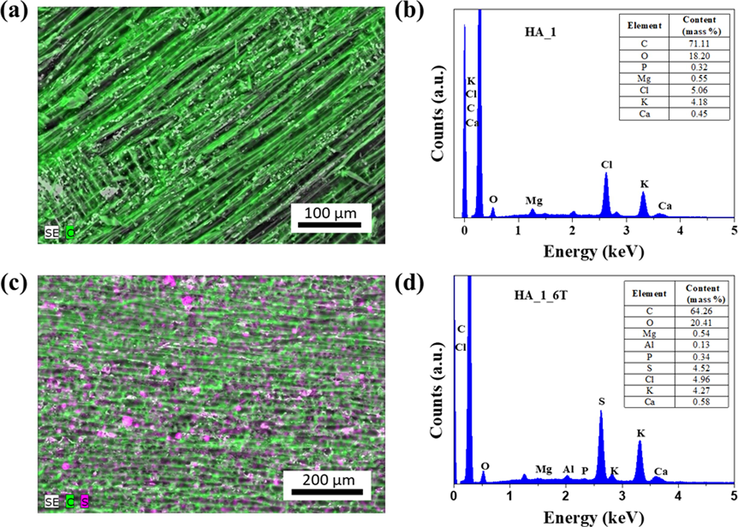
SEM and SEM-EDS/EDX analysis of (a, b) HA_1 and (c, d) HA_1_6T samples after the introduction of 6 T. SEM-EDS/EDX images are representative for the whole set of investigated samples.
The data in Table 1 prove the efficiency of dye deposition. After dye adsorption, structural parameters like SBET, Vmi, and Vt got reduced dramatically. This effect results from the phenomenon of dye molecules’ deposition on pores whose surface and volume substantially contribute to the SBET, Vmi, and Vt values. Fig. 2a shows the isotherms for the carbons’ low-temperature adsorption of nitrogen. According to the IUPAC classification (Thommes et al., 2015), these isotherms were of type I, which suggests that the carbon materials were strictly microporous. The volume of micropores is presented in Table 1, ranging from 0.153 to 0.291 cm3 g−1 and contributing greatly to the total pore volume. The pore structure is distinguished by a very narrow pore size distribution function (PSD), i.e., only pores of non-differentiated dimensions contribute to the total pore volume (Fig. 2b). The calculated dimensions of pores lead to calling these fabricated nanoporous carbons ‘molecular sieves.’ Running the PSD function on HA_X revealed maxima in the micropore range, placed at 1.77 and 1.94, as well as very small mesopores (maximum placed at 2–3 nm).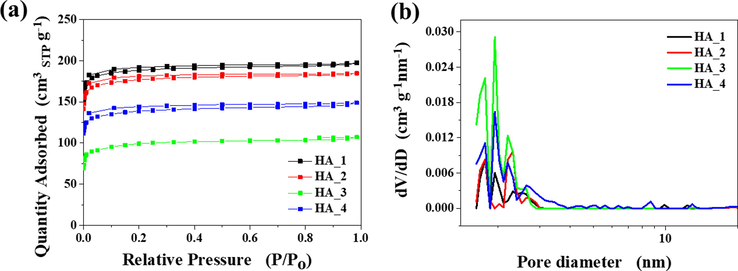
(a) Nitrogen adsorption-desorption isotherms and (b) PSD functions determined from corresponding nitrogen adsorption isotherms of HA_X samples.
SEM was used to identify inner carbon structure morphology. Fig. 3 presents a series of SEM images recorded for HA_1 carbon (at different magnifications). Some specific details are visible for wood-derived carbons, such as residues of the original wood-tissue structure. Generally, the structure and shape of tissue is very different after carbonization, depending on the type of wood and part of tree subjected to carbonization. As expected, the HA_1 sample consists of numerous cavities and regular walls as far as the external surface, however many irregular pore-looking details are also present. These macropores serve, as in other wood-originated ACs, as entrances to pores of smaller size, like micro- and mesopores. Macropores usually play the role of transporting channels for adsorbate molecules and the number of irregular pores increases adsorption on the adsorbent (Cyganiuk et al., 2010, 2013).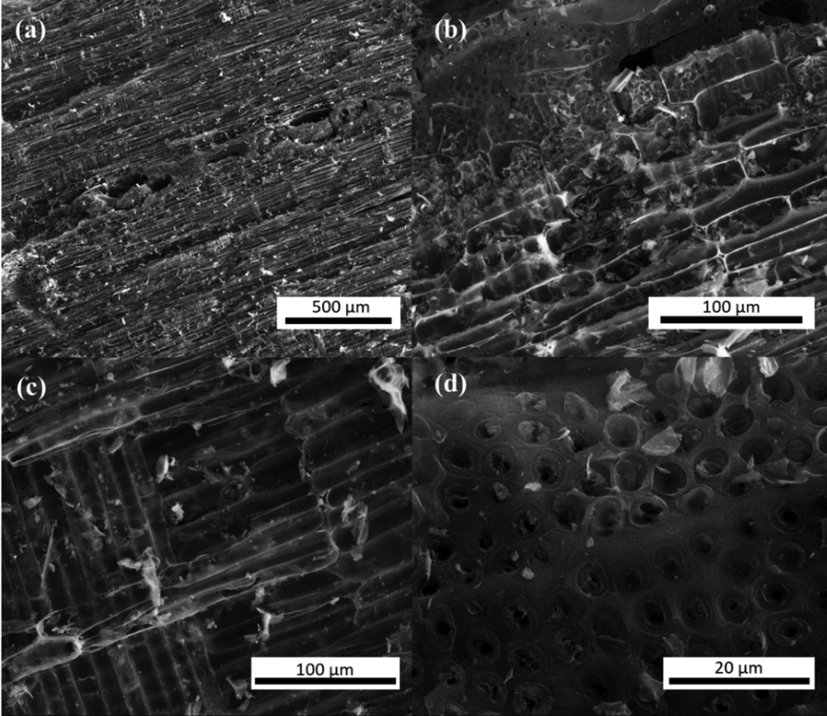
SEM images of HA_1 with different magnifications. The images are representative for the whole set of investigated samples/carbons.
Carbon-carbon bonding of the wood-derived carbons was probed with the Raman spectra (Fig. 4a and 4b) using an excitation wavelength of 488 nm. The most intense bands were found in the spectral region between 600 and 3000 cm−1. All materials exhibited outstanding D and G bands. The D band (at 1340 cm−1) usually belongs to A1g, it becomes activated due to the occurrence of defects in the carbon lattice. The high-frequency G band (at 1590 cm−1) is assigned to E2g, stretching the vibration of the C–C band; the G band reflects the structure of a sp2 hybridized carbon atom. The intensity ratio of D and G bands (ID/IG) quantifies the extent of defects found in carbon materials after surface modification. The ID/IG ratios of HA_1, HA_2, HA_3, and HA_4 are 0.90, 0.91, 0.88, and 0.89 respectively. The ID/IG ratios of HA_1_6T, HA_2_6T, HA_3_6T, and HA_4_6T are 0.90, 0.82, 0.81, and 0.91 respectively. The ID/IG ratios are similar, around 0.9, which indicates that similar graphite-like structures are present in the heat-treated ACs. Overall, a relatively low number of structural defects occurred (Shimodaira et al., 2001; Peng et al., 2014; Kristianto et al., 2016).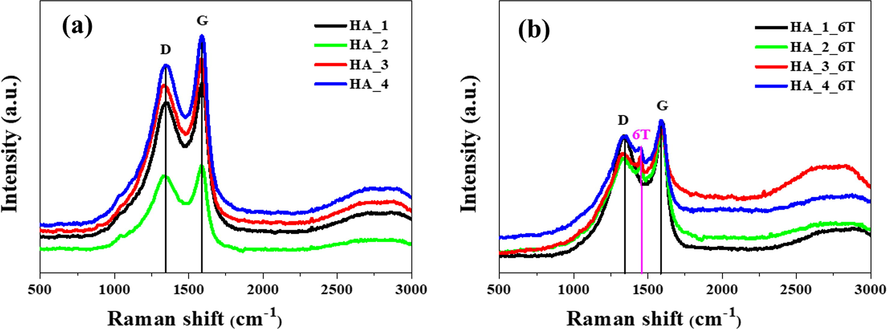
Raman spectra of carbon obtained in series: (a) HA_X and (b) HA_X_6T.
In order to confirm the immobilization of 6 T on the outer surface of the tested carbons, confocal microscopy studies were undertaken as an alternative characterization method. Fig. 5a and 5b present confocal microscopy images for representative samples HA_1_6T and HA_2_6T (red emitting). The investigated 6 T exhibit emission tested at λ at 594 nm (two vibronic side bands at 640 and 700 nm for α-sexithiophene). Essentially, dye adsorption occurs over the entire surface of natural carbon, in comparison with the uneven dye deposition of carbon nanotubes reported by Kamedulski et al. (Kamedulski et al., 2018). Additionally, Raman spectra (Fig. 5b) decreased the ID/IG values slightly for the ACs subjected to dye adsorption. Only for the HA_4_6T sample was the ID/IG ratio higher than for pure material, which means that there were some small defects on the surface of the carbon structure. Furthermore, a new peak appeared at 1443 cm−1 after the introduction of 6 T (C–C stretching, band derived from dye 6 T) which is not present in typical spectra of pure carbon materials. These spectra results confirm that 6 T is well adsorbed onto the surface of the carbon materials obtained here. Generally, the specific surface area for all samples after 6 T immobilization decreased to a range of 2–4 m2 g−1. This parameter confirms the adsorption of oligothiophene dyes in the pores of activated carbon.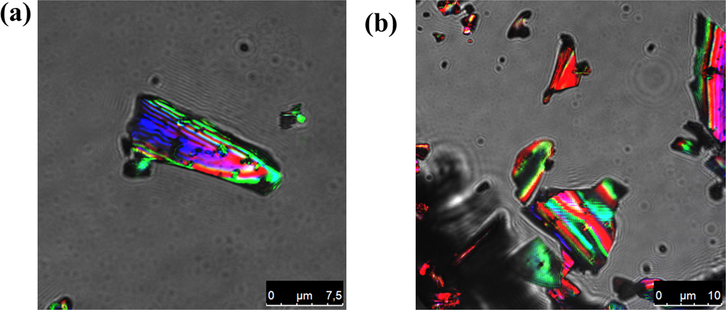
Confocal microscopy images of (a) HA_1_6T and (b) HA_2_6T.
A look at the practical performance of the materials described in this study will be part of another paper; the future publication will summarize the applicability of all oligothiophene-carbon hybrids. Before testing any oligothiophene-carbon hybrid as a DSSC electrode, it should be made certain that there is an effective process and quality dye deposition, which was one of the main targets of this study.
4 Conclusions
In this study, samples of four Egyptian wood species, Delonix regia, Leucaena leucocephala, Salix mucronate, and Tipuana tipu, were used as carbon source materials in a simple method of preparing activated carbon. These ACs were found to have their structural parameters very effectively improved through KOH activation. As follows, the present work has proven that selected wood wastes accessible in Egypt may be considered a promising raw material for the preparation of activated carbon with a surface area of up to 603 m2 g−1. The manufacturing process, as assumed, relies on common and inexpensive raw materials/reagents (wood scraps and KOH) and consumes relatively little energy (heat-treatment performed at 600 °C). The emerging and ambitious application of ACs in the construction of carbon-based DSSC requires carbon adsorbents of high adsorption capacity towards organic dyes. Present research proves that this is possible in the case of ACs obtained from Egyptian wood. In particular, these ACs offer high adsorption capacity towards an oligothiophene dye which is often regarded as suitable for DSSC design. The proposed synthesis pathway is an efficient and inexpensive base for manufacturing optically sensitive materials in the production of dye-sensitized solar cells (DSSC). These low-cost materials and their use may contribute to ecosystem preservation; current focus on protecting the environment will likely cause the production of these materials to increase rapidly in the near future. This aspect of the performed study will be continued in further research.
Acknowledgements
This work was supported by the National Science Centre under Grant no. 2018/29/N/ST5/01240.
References
- A new type of counter electrode for dye sensitized solar cells based on solution processed SnO2 and activated carbon. Mater. Sci. Semicond. Process.. 2015;39:223-228.
- [Google Scholar]
- Biotechnological fabrication of LaMnO3-carbon catalyst for n-butanol conversion to ketones. Carbon. 2010;48:99-106.
- [Google Scholar]
- Nanoscale phenomena occurring during pyrolysis of salix viminalis wood. J. Mater.. 2013;2013:9.
- [Google Scholar]
- Preparation of activated carbon from green coconut shell and its characterization. J. Chem. Eng. Process Technol.. 2015;6:1-7.
- [Google Scholar]
- Study of chemical activation process of a lignocellulosic material with KOH by XPS and XRD. Microporous Mesoporous Mater.. 2003;60:173-181.
- [Google Scholar]
- Study on conventional carbon characteristics as counter electrode for dye sensitized solar cells. J. Phys.: Conf. Ser. IOP Publishing 2017 012044
- [Google Scholar]
- Adsorption of anionic and cationic dyes on activated carbons with different surface chemistries. Water Res.. 2004;38:2043-2052.
- [Google Scholar]
- Regioregular poly (3-hexyl-thiophene) helical self-organization on carbon nanotubes. Appl. Phys. Lett.. 2009;95:181.
- [Google Scholar]
- Review on dye-sensitized solar cells (DSSCs): Advanced techniques and research trends. Renew. Sustain. Energy Rev.. 2017;68:234-246.
- [Google Scholar]
- Effect of KOH ratio on the formation of activated carbon from pressed wood residues. Int J Pharm Sci Res. 2017;8:4875-4880.
- [Google Scholar]
- Efficiency enhancement of natural dye sensitized solar cell by optimizing electrode fabrication parameters. Mater. Sci.-Poland. 2017;35:816-823.
- [Google Scholar]
- Facile preparation of self-assembled hydrogels constructed by poly-cyclodextrin and poly-adamantane as highly selective adsorbents for wastewater treatment. Soft Matter 2019
- [Google Scholar]
- Earth-abundant carbon catalysts for renewable generation of clean energy from sunlight and water. Nano Energy. 2017;41:367-376.
- [Google Scholar]
- Nano-structured carbon matrixes obtained from chitin and chitosan by a novel method. J. Nanosci. Nanotechnol.. 2016;16:2623-2631.
- [Google Scholar]
- Pyrolysis of Chlorella vulgaris as a green chemistry method for manufacturing of nitrogen doped porous carbon materials of high application potential. Mater. Express. 2017;7:25-34.
- [Google Scholar]
- Synthesis of N-rich microporous carbon materials from chitosan by alkali activation using Na2CO3. Mater. Sci. Eng., B. 2015;201:66-71.
- [Google Scholar]
- Novel counter electrodes of dye-sensitized solar cells based on activated carbon prepared from wood of Choerospondias axillaris seed-stones and Alnus nepalensis plant. Int. J. Eng. Adv. Res. Technol. (IJEART). 2017;3:8-11.
- [Google Scholar]
- Effective Synthesis of Carbon Hybrid Materials Containing Oligothiophene Dyes. Materials. 2019;12:3354.
- [Google Scholar]
- Influence of intermolecular interactions on the properties of carbon nanotubes. Bull. Mater. Sci.. 2018;41:76.
- [Google Scholar]
- Low-cost dye-sensitized solar cells with novel counter electrodes based on activated carbon of Rhododendron arboreum plant wood. Int. J. Sci. Eng. Appl. Sci.. 2017;3:134-138.
- [Google Scholar]
- Katesa, J., Junpiromand, S., Tangsathitkulchai, C., 2013. Effect of carbonization temperature on properties of char and activated carbon from coconut shell. Qingdao Daxue Shifanxueyuan Xuebao/J. Teachers College Qingdao University 20.
- Kristianto, H., Arie, A., Susanti, R., Halim, M., Lee, J., 2016. The effect of activated carbon support surface modification on characteristics of carbon nanospheres prepared by deposition precipitation of Fe-catalyst. IOP Conference Series: Materials Science and Engineering. IOP Publishing, p. 012034.
- A microporous and high surface area active carbon obtained by the heat-treatment of chitosan. Carbon. 2012;50:3098-3101.
- [Google Scholar]
- Use of organic materials in dye-sensitized solar cells. Mater. Today. 2017;20:267-283.
- [Google Scholar]
- Preparation of activated carbons from poplar wood by chemical activation with KOH. J. Porous Mater.. 2017;24:193-202.
- [Google Scholar]
- Response to “Some remarks on a critical review of the estimation of the thermodynamic parameters on adsorption equilibria. Wrong use of equilibrium constant in the van't Hoff equation for calculation of thermodynamic parameters of adsorption-Journal of Molecular Liquids 273 (2019) 425–434”. J. Mol. Liq.. 2019;280:298-300.
- [Google Scholar]
- Encapsulation of conjugated oligomers in single-walled carbon nanotubes: towards nanohybrids for photonic devices. Adv. Mater.. 2010;22:1635-1639.
- [Google Scholar]
- Preparation and aggregate state regulation of co-assembly graphene oxide-porphyrin composite Langmuir films via surface-modified graphene oxide sheets. Colloids Surf., A. 2020;584:124023.
- [Google Scholar]
- Carbon nanoforms for photovoltaics: myth or reality? Adv. Energy Mater.. 2017;7:1601102.
- [Google Scholar]
- Improvement in photovoltaic performance of dye sensitized solar cell using activated carbon-TiO 2 composites-based photoanode. IEEE J. Photovoltaics. 2016;6:1191-1195.
- [Google Scholar]
- Graphene–organic hybrids as processable, tunable platforms for pH-dependent photoemission, obtained by a new modular approach. J. Mater. Chem.. 2012;22:18237-18243.
- [Google Scholar]
- Novel nitrogen-containing mesoporous carbons prepared from chitosan. J. Mater. Chem. A. 2013;1:8961-8967.
- [Google Scholar]
- Formation of carbon nanosheets via simultaneous activation and catalytic carbonization of macroporous anion-exchange resin for supercapacitors application. ACS Appl. Mater. Interfaces. 2014;6:20795-20803.
- [Google Scholar]
- Qiao, Q., 2011. Carbon nanostructures as low cost counter electrode for dye-sensitized solar cells. Solar Cells-Dye-Sensitized Devices. IntechOpen.
- Low-cost dye-sensitized solar cells based on interconnected FTO-activated carbon nanoparticulate counter electrode showing high efficiency. J. Mater. Sci. Eng. A. 2015;5:361-368.
- [Google Scholar]
- Natural dyes for dye sensitized solar cell: A review. Renew. Sustain. Energy Rev.. 2017;69:705-718.
- [Google Scholar]
- Production and applications of activated carbons as adsorbents from olive stones. Biomass Convers. Biorefin. 2019:1-28.
- [Google Scholar]
- A review of ancient Egyptian pigments and cosmetics. Stud. Conserv.. 2016;61:185-202.
- [Google Scholar]
- Shimodaira, N., Masui, A., Takada, A., Shinozaki, Y., Tomita, N., 2001. Structural information from the Raman spectra of activated carbon materials. American Carbon Society. 25th Biennial Conference on Carbon, Hyatt Regency Lexington, Lexington, pp. 14–19.
- Physisorption of gases, with special reference to the evaluation of surface area and pore size distribution (IUPAC Technical Report) Pure Appl. Chem.. 2015;87:1051-1069.
- [Google Scholar]
- Black perspectives for a green future: hydrothermal carbons for environment protection and energy storage. Energy Environ. Sci.. 2012;5:6796-6822.
- [Google Scholar]
- A review of chemicals to produce activated carbon from agricultural waste biomass. Sustainability. 2019;11:6204.
- [Google Scholar]
- Nanomaterials for the adsorptive treatment of Hg (II) ions from water. Chem. Eng. J.. 2019;358:264-282.
- [Google Scholar]
- N-doped porous carbon material made from fish-bones and its highly electrocatalytic performance in the oxygen reduction reaction. RSC Adv.. 2015;5:48965-48970.
- [Google Scholar]
- KOH activation of carbon-based materials for energy storage. J. Mater. Chem.. 2012;22:23710-23725.
- [Google Scholar]
- Recent advances in applications of activated carbon from biowaste for wastewater treatment: a short review. J. Cleaner Prod.. 2018;175:361-375.
- [Google Scholar]
- Preparation of highly porous carbon from fir wood by KOH etching and CO2 gasification for adsorption of dyes and phenols from water. J. Colloid Interface Sci.. 2006;294:21-30.
- [Google Scholar]
- Preparation of highly microporous carbons from fir wood by KOH activation for adsorption of dyes and phenols from water. Sep. Purif. Technol.. 2005;47:10-19.
- [Google Scholar]
- Preparation of activated carbon from desiccated coconut residue by chemical activation with NaOH. J. Mater. Sci. Res.. 2015;5:24.
- [Google Scholar]
- Enhanced performance of dye-sensitized solar cells with activated carbons. J. Nanosci. Nanotechnol.. 2013;13:7875-7879.
- [Google Scholar]
- New-generation integrated devices based on dye-sensitized and perovskite solar cells. Energy Environ. Sci.. 2018;11:476-526.
- [Google Scholar]
- A facile preparation method for new two-component supramolecular hydrogels and their performances in adsorption, catalysis, and stimuli-response. RSC Adv.. 2019;9:22551-22558.
- [Google Scholar]







